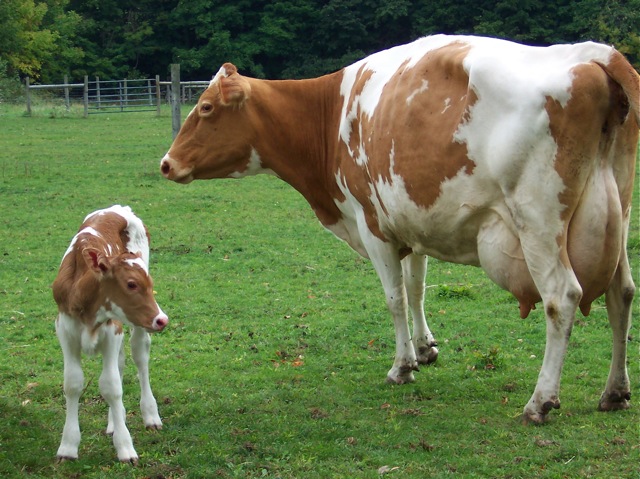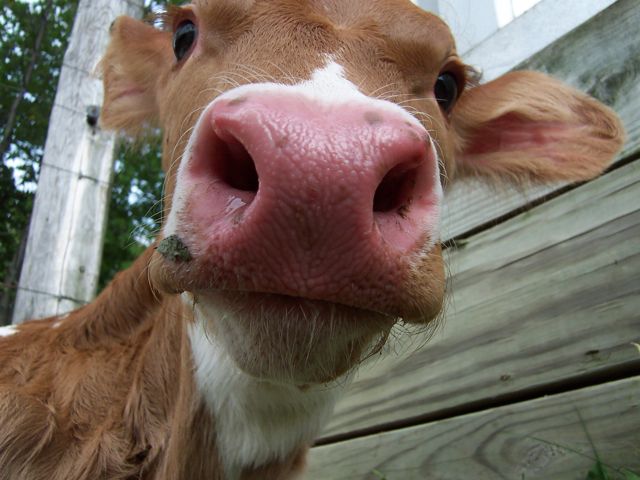
reference-image, l
(article, Laura Grace Weldon)
[%pageBreakSettings nobreak=true] I stuff my pockets with carrots before heading out back. Pausing at the garden, I pull rutabagas and flowering broccoli, then walk past the creek and up the tree-lined path. Chickens wander alongside to see what I’ve brought. Although my arms are nearly full, I bend to pick plantain before opening the barnyard gate. Isabelle is in the side pasture with her two calves. I walk to her, rutabaga leaves waving in time to my steps, as she hurries toward me with the lumbering grace of a matronly Guernsey. Like shy but exuberant dancers, her calves follow in leaps and half-turns, their eyes bashfully averted. Isabelle takes the food from my fingers gently, her soft lips brushing my skin. When I fumble, she waits patiently, drooling in anticipation as I snap the next carrot in half. A few weeks ago, during our evening-snack ritual, she dropped a mouthful of food, refusing to touch it again, yet took the next handful I offered. Later, I realized that morning glory was growing in the patch of clover I’d picked for her. Isabelle had immediately detected the presence of a plant toxic to her heart. [%image reference-image float=right width=400 caption="Isabelle and one of her calves."] The calves watch their mother eat. Tentatively, they lean forward to touch rutabaga leaves with their noses. Although curious, they prefer their mother’s milk. Their idyllic lives — out on pasture with their mother, nursing on demand — are rare on today’s dairy farm. Most dairy calves are separated from their mothers soon after birth. It’s considered more cost-effective to give the calves something called "calf milk replacer." But this white fluid resembles cow milk only to lab analysts, as the ingredients may include wheat, soy, lard, fish, and animal plasma (often from pig blood). When we were new to farming, everything we read warned that a calf left with its mother to nurse freely was likely to develop scours, a potentially fatal condition. We couldn’t imagine that nature had it wrong and agriculture manuals had it right. Besides, we had no intention of separating mother from calf. A little research showed that the experts were looking at it the problem upside down. Scours is more likely to happen in calves taken from their mothers so soon that they’re deprived of the antibody-rich colostrum that flows from their mothers’ udders right after birth. Isabelle is an attentive mother. She teaches with nudges, head movements, and a variety of vocalizations. She stands still when her calves choose to nurse, moving no more than her tail to flick away flies. Each of Isabelle’s calves has been significantly bigger than the average for her breed, with no medical problems. And we’ve always had more than enough milk for our human family while she nurses a calf or two for a year. On our farm, the bond we witness between cow and calf forces us to recognize the toll taken by standard agricultural practices. One day, we were at a nearby dairy when farmhands came to take a day-old calf from its mother. As the men approached, a dozen other cows in the pen formed a circle against them, keeping the mother and calf in the center. After losing the struggle to protect one of their own, the cows began bawling, and soon the cows in the other buildings joined in. We could hear them as we drove away. All around us, dairy farms isolate calves in “calf huts,” where they’re fed calf milk replacer. Most often, their mothers live confined indoors, their sensitive noses smelling their own calves and green grass, both forever beyond their reach. Our veterinarian tells us that in 26 years, he’s never seen dairy calves raised alongside their mothers except on our farm. He remains astonished by what he regards as the uncharacteristic size and robust health of the calves here. Isabelle belches appreciatively. It smells like the hay we harvested last summer. Gas emissions from both ends of cattle have been blamed for contributing to global climate change. Yet studies indicate that the net effect of grass-fed cattle actually slows global warming. Confinement farming and unnatural feeding are the problem. Cattle have evolved to thrive on nothing but grass and its dry counterpart, hay. It’s another of nature’s miracles that cows can grow so large and produce such rich milk purely from grass, a plant inedible to humans. Yet according to Jo Robinson's book [%amazonProductLink "Pasture Perfect: The Far-Reaching Benefits of Choosing Meat, Eggs, and Dairy Products from Grass-Fed Animals" asin=0967811619], cattle on today’s farms are fed diets heavy in grains, protein supplements, and bulking agents such as cardboard, chicken feathers, and stale candy. Even plastic pot scrubbers have been used to replace the roughage that simple grass naturally provides. These artificial diets cause a range of physical disorders, so the typical cow diet is further adulterated with synthetic nutrients and medications. [%image featurette-image float=right width=400 caption="A cow's nose."]Pastured cows have fewer reproductive problems and produce larger, healthier calves. The more fresh grass a cow eats, the more vitamin E, omega-3 fatty acids, and cancer-fighting conjugated linoleic acid (CLA) she’ll produce in her milk. In fact, the older a cow gets, the higher the CLA levels in her milk. But dairy cows in this country don’t live long. They’re culled at three, four, maybe five years old. Overproduction, unnatural diets, and confinement make them unprofitable after that age, even though cows can easily reproduce and give milk well into their teens. Isabelle is nearly 12 years old. She chooses to spend most of her time outdoors. She’s curious about anything new going on nearby, and mindful of chickens pecking underfoot. Such curiosity is typical of her kind. Even animal researchers have been surprised to discover 'cattle, a moment so gratifying that some cows leap in the air. Isabelle, though a middle-aged lady, regularly indulges in those leaping moments. She scampers girlishly, tosses her head, and runs in sheer pleasure. When she lies down to rest, she lets the barn cats sleep on her warm hide. Isabelle chews slowly. Her teeth crunch on broccoli and her tongue flicks out to catch a wayward cluster before it falls. Cattle seem to be contemplative eaters. Given free pastoral range, they select grasses with high nutrient levels, instinctively self-medicating with the right plants when ill. They choose to graze alongside favorite herd mates, just as we prefer lunching with friends. After eating, they digest as all ruminants do, chewing their cud to enjoy the meal all over again. My hands are empty now. I stroke Isabelle’s face and manage to rub the nearest calf’s hide. Soon they’ll wander back to the shady part of the pasture together. There they’ll eat grass, or milk made from grass, eating within the perfect circle of sun, soil, and sustenance. The calves will nap under an apple tree’s long shadow and Isabelle will bring up rutabagas, broccoli, and carrots to chew again, a reminder of a meal offered by loving hands. p(bio). Laura Grace Weldon lives with her family on Bit of Earth Farm in Ohio. Her book [%amazonProductLink "Free Range Learning" asin=193538709X]_ comes out this summer.

reference-image, l

featurette-image, l